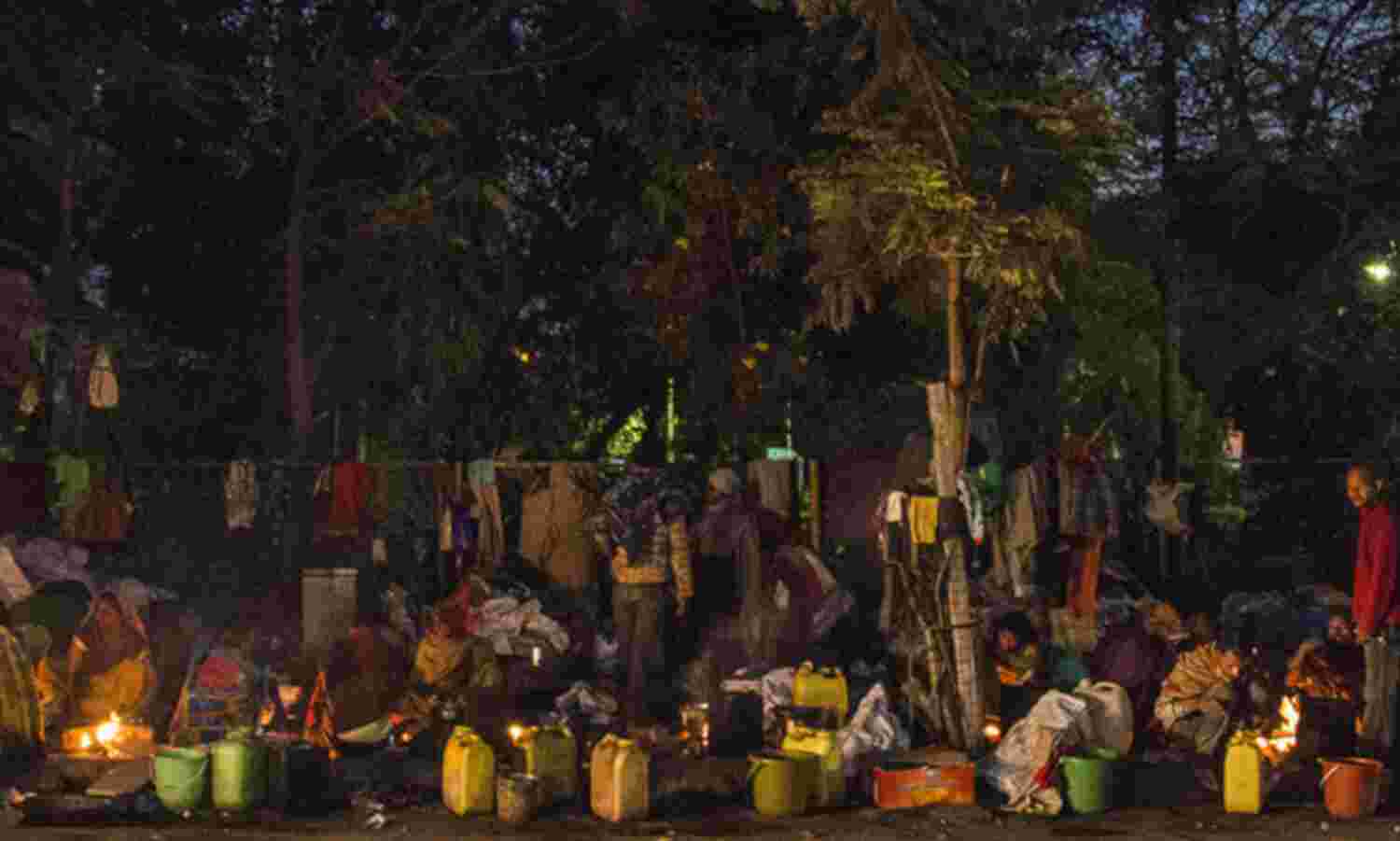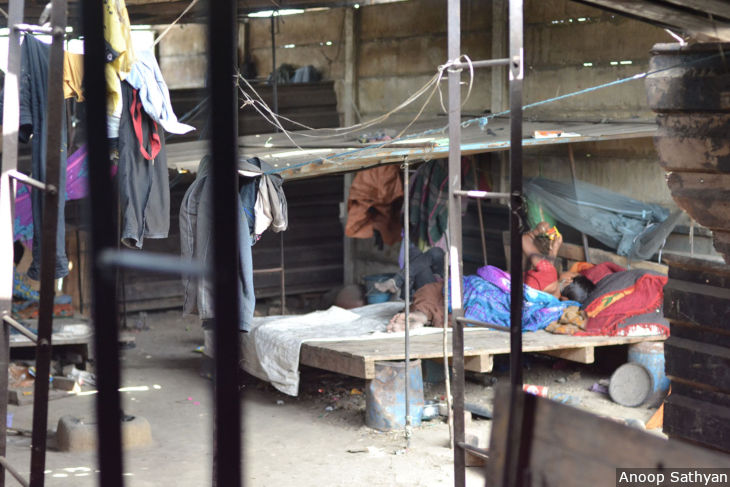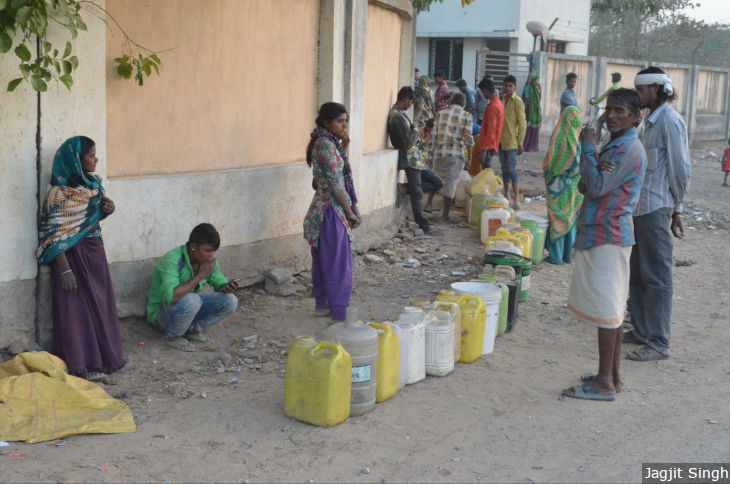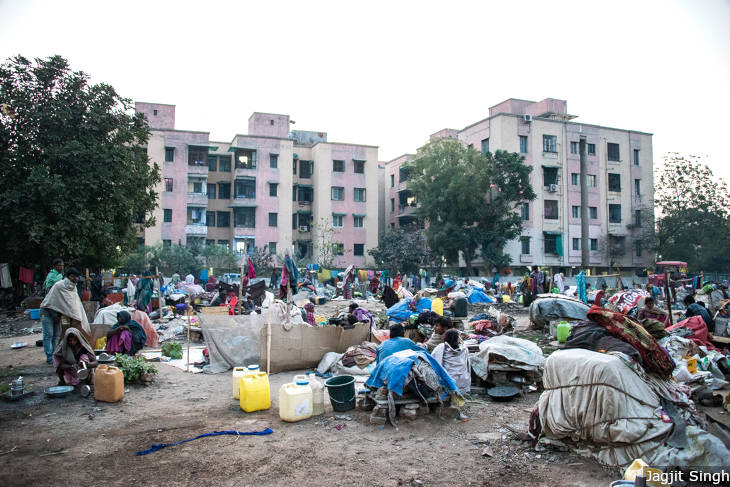Why India's New Wage Code Will Push Migrants Deeper Into Poverty

Ahmedabad: “I get Rs 300 for a day’s work and this is the best work I can get,” said Kamlesh*, an Adivasi migrant worker from Banswara in southern Rajasthan.
For Kamlesh, “best work” involves 12-hour shifts, without a single day off, at a garment factory in Ahmedabad. For cleaning ash from a boiler machine while it is running in high heat, he earns Rs 9,000 a month.
Although Kamlesh has been in Ahmedabad for over a decade, he continues to live in an empty lot outside the factory walls to save on rent. This allows him to send his family in Banswara some money.
The landmark Code on Wages, which was passed on August 2, 2019, will have many consequences for the lives and livelihoods of millions of India’s migrant workers who, like Kamlesh, perform the manual labour that powers India’s urban-centric economic growth.
The Act claims to consolidate and codify four major wage-related legislations--the Minimum Wages Act (1948), Payment of Wages Act (1936), Equal Remuneration Act (1976), and Payment of Bonus Act (1965)--in order to simplify them, and enhance their compliance and coverage. But it dilutes or removes critical provisions for the protection of wages, marking the end of pro-worker legislations, say trade unions, workers’ organisations and experts.
The central government has announced that the national floor minimum wage (which no state government can further reduce) would be set at Rs 178 under the Act, only Rs 2 more than the amount declared two years ago. Taking inflation into account, this increase of 1.36% in wages translates into a decline in real wages.
While it has been unclear whether Rs 178 will indeed be the national floor wage, the Act neither defines a minimum wage nor lays down a methodology for determining it. Rather than being a pro-worker legislation that guarantees workers the ability to maintain a level of consumption for a minimum standard of living, it leaves the fixing of minimum wages to the discretion of states.
Kamlesh, and many others like him, are classified as circular migrant workers--they remain at their work destinations for anywhere between three and 11 months a year, but are unable to settle there. This keeps them continuously on the move, between their village and one or more work destinations.
Nation-wide, such workers number 80 million and account for 15-20% of the workforce, according to Ravi Srivastava, a co-author of a 2007 report prepared by the National Commission for Enterprises in the Unorganised Sector. Other scholars of migration, such as Priya Deshingkar, place the number at over 100 million.
Kamlesh’s home state, Rajasthan, alone contributed 5.79 million circular migrant workers to the workforce in 2014, according to Aajeevika Bureau, a Rajasthan-based non-profit initiative that provides support and security to circular migrant workers.
Accounts of such workers, among the most impoverished sections of the Indian workforce, revealed that even current minimum wage levels have disastrous consequences. They live in acute deprivation, as we explain later, their vulnerability is exploited by their employers and they are left out of urban welfare schemes because they lack an urban address.
Aajeevika Bureau conducted a survey on migrant workers in 2019. The study featured 337 labourers from Rajasthan, Gujarat, Uttar Pradesh, Bihar and Madhya Pradesh, documenting their access to housing, water, sanitation, health and food in Ahmedabad. It looked at both, the ease of accessing these commodities as well as their quality.
Conducted across rented rooms, open settlements and worksite housing in Ahmedabad, the study aimed to understand the physical, mental and monetary costs of this access. By quantifying workers’ incomes and expenditures on basic commodities, we asked a fundamental question: At current wage levels, how do circular migrants survive in the city?
Exploited and excluded
Ahmedabad, the poster child of the Gujarat model of development, has been recognised as one of the fastest growing cities in the world. It is also a big destination for circular migrant workers who form a substantial chunk of the workforce in three major sectors--construction, factories, and hotels and restaurants. A large number of these migrants are Adivasis from northern Gujarat, western Madhya Pradesh and southern Rajasthan, who are becoming increasingly dependent on migration for survival.
Circular migrants come from different regions and backgrounds, but they have one thing in common--they remain outside the purview of the state. Employed in the lowest echelons of these sectors--in informal, casual or contractual jobs--and often in unregistered units, they fall through the cracks of the state’s regulatory oversight, allowing employers to renege on their legal responsibility of ensuring the welfare of workers.
Labour contractors and employers prefer circular migrants precisely because they are cheap and flexible labour that allows them to cut costs. But without domicile status or formal documentation in the city, they cannot access public schemes either. These workers are trapped on all sides, as we mentioned earlier, surviving on very little and excluded from public provisioning.
Village is always ‘vatan’
Despite continuously subsidising Ahmedabad’s growth, circular migrants have a temporary relationship with the city, frequently traveling home for festivals or agricultural work.
“The village is my vatan [home],” said Mukheshbhai, a Rajasthani construction worker living in the open in Chandlodiya. “We only come to the city to earn.” In the Raipur area of Ahmedabad, another construction worker insisted that despite living in the city for 10 years, he did not want to vote here. He always votes for the panchayat elections in his village because it is his sarpanch who will eventually work for his family’s vikas or development, he said.
“Humari kaun sunega shahar mein? [Who will pay any attention to us in the city]?” asked an Adivasi worker operating the boiler inside a factory.
While some migrants trace their temporary relationship with the city by asserting their belonging to the village, others fear stigmatisation as “outsiders” and the near impossibility of gaining any social capital. For both groups, the city is primarily a source of wages to be spent on subsistence farming, exorbitant debts and family sustenance in the village. Adivasi families in particular must invest in their social standing in the village by contributing to weddings, funerals and historical lending and borrowing practices, which are inextricably linked to their community membership.
15 workers in 10x10 sq ft windowless room
At Ahmedabad’s current daily minimum wage of Rs 312.20 and Rs 329.20 for unskilled and skilled workers respectively, migrants are compelled to go to desperate lengths to cut living expenses. In doing so, they must compromise on the quality and adequacy of housing, food, water and sanitation.
Rent is, perhaps, the only reasonable chunk of spending that circular migrants can save. On average, the monthly rent for a 10x10 pucca (permanent) room in Ahmedabad’s informal rental market is Rs 3,000 for a family. Adivasi workers, who do not have access to regular daily work at the labour nakas (daily recruiting points) in the city and rarely move into higher-paying skilled labour, cannot afford to live in such spaces while also purchasing adequate food on average incomes of Rs 7,000 per month. As a result, they compromise by living on their worksites, in the open, or in small and dangerously overcrowded rooms all these take a significant physical and mental toll on them.
In a ‘chali’ in Raipur, Ahmedabad, up to 15 workers--all men--occupy a 10x10 sq ft windowless area, where they also store their belongings, water containers and food vessels. These Adivasi construction workers from Rajasthan pay Rs 500 per month on rent, but their landlord, in order to maximise profits, has placed no cap on the number of workers who share a room. As a result, workers are crammed into rooms with no more than 7 sq ft per person, most of them forced to sleep on slanted tin roofs or on platforms outside the room. This, in effect, means that they are paying rent only for a space to store their belongings.
The ‘cost’ of living onsite for free
Severely compromised access to public provisioning also faces workers living on their worksites, either to save on rent or because they travel as families, and as a result, cannot afford Ahmedabad’s expensive rental markets.
At a dhaba in the Anjali Vistar area, workers living onsite must fill enough water during a two-hour window (6am-8am) not only for their own usage (drinking, bathing, washing clothes), but also to wash the restaurant’s dishes. As a result, their daily water consumption, much like that of construction and factory workers living onsite, is mediated by the supply of water, not their needs.
On average, the dhaba’s staff consumes only 37 litres of water per day, 63% lower than the 100 litre minimum needed to live a hygienic life, recommended by the National Commission on Urbanisation (1988) and 73% lower than the 135 litre minimum recommended by the Bureau of Indian Standards for “economically weaker sections”.
On construction and factory sites, while workers access water, sanitation, electricity and sometimes fuel, this access is mediated by a relationship of both patronage and exploitation with their contractor. The contractor can call workers in to work at any hour of the day, expect unpaid overtime work, and deny any leaves unless machines are broken or the site is not functioning.

On construction and factory worksites, workers save on rent but must submit to the whim of extractive contractors and landlords, resulting in unpaid overtime work, and unreliable access to sanitation, water and cooking fuel.
Often, promised facilities are non-existent or dysfunctional--some toilets might not have doors, forcing women to wake up as early as 4 am to access safe sanitation kilometres away from the site. These “perks” are so arbitrary that firewood might be free one week and become chargeable the next. Left without any emergency funds, workers living onsite are often forced to rely on this extractive relationship with their contractors for cash advances as well, which pays for illness, weddings, deaths and debts in their villages.
The costs of saving rent in this way are manifold. Not only is the “free” access to basic goods onsite factored in to workers’ wages--those living onsite are paid less (as low as Rs 250 per day for unskilled work) than the workers who access work from labour nakas (paid up to Rs 350 per day)--workers must also bear the burden of unpredictable access to inadequate water and sanitation. While contractors and employers are legally mandated to provide decent living conditions and welfare provisions to migrant labour onsite, a lack of regulatory oversight makes access dependent on the whim of the contractor or employer.
The lives of Adivasi families living in the open, to save on rental accommodation, are marked by even more uncertainty than those living on worksites. Each day entails a hunt for water, a safe space for their sanitation needs, and a search for firewood.
For women living in the open, a perpetual hunt for water and toilets
“If we wake up a little late after there is daylight, and go to defecate in the open, the railway authorities pelt us with stones or beat us with big sticks,” said Sumanben, a migrant Adivasi woman who lives on public land near a railway track. “Sometimes there is a watchman at night. If he is there then we cannot defecate that day.”
For many other women, who live in the midst of busy roads in the city, open defecation is impossible. They report spending Rs 15 everyday to be able to use the toilet and bathe at pay-and-use toilets, forfeiting nearly two days’ wages per month. Their hunt for water involves a similar ordeal--going from building to building nearby, hoping to find a security guard or a resident who will not turn them away that day. On their walk back from the construction site, the women scavenge for discarded cardboard, sticks and plastic to cook meals for their families. If they are unsuccessful, they are forced to spend Rs 80 per day on firewood from the market.

Unable to access municipal water connections in the open, migrant workers rely on arbitrary access, often depending on the benevolence of nearby residents to let them fill enough water for their families.
Paying to live on the streets
Living in open spaces also brings the constant threat of eviction and harassment by local power groups, the municipal authority or nearby societies, even if migrant workers have been coming back to the same space for years.
“We were living in one place for seven years, but one day someone told us that we have to go as he wants to construct a house on it,” said a construction worker living on an open settlement in Durganagar. “When we came here, another local showed up with a map, telling us that this land belongs to him and that we have to pay him.” Shantaben is still forced to pay this man, who likely has no claim to the land she is living on, Rs 500 per month, not knowing when she will have to move out of that space with her family.

While living in the open, migrant workers are susceptible to eviction by the police or the municipal corporation, as well as harassment from residents of nearby buildings. -
In overcrowded rented rooms, worksites with extractive contractors and open spaces, migrant workers live with no networks to rely on. Women, in particular, work longer hours, live in unsafe conditions, and constantly bear the cognitive burden and risk of living without the bare minimum required for everyday survival.
Food is the biggest expense
For the migrants, food comprises the largest proportion of spending. On average, a circular migrant family of four reported spending Rs 2,000 per week on food rations. Workers who do pay rent in the city reported that their monthly food expenditure is between two and just over six times their monthly rent.
Construction workers living in open spaces with their families reported spending, on average, 53% of their monthly income on food and fuel--the highest among all workers across occupation and housing type. This is not only true because their absolute monthly incomes are lower than those who can afford to live in rented rooms, but also because living in the open brings its own additional costs.
Workers living in open spaces are unable to purchase food even for a week at a time, and cannot bring wheat or other grains from their village to the city, because of the lack of storage space. As a result, they must buy grains, vegetables and oil daily from expensive open markets, significantly raising their spending on food rations in the city. Even after bearing the most severe kinds of burdens while living in the open, they deal with the highest cost as a proportion of their incomes to access basic provisioning in Ahmedabad.
Adivasis bear the heaviest burden
It is no coincidence that the workers who are forced to bear such burdens and face the most uncertainty and harassment in the city are Adivasis. They are already marginalised and stigmatised, receive the lowest wage rates, perform hazardous work and are most excluded from the state’s public provisioning.
Of the 337 workers interviewed during this survey, it was workers belonging to “other backward classes” and “general castes”, mainly domestic workers and headloaders, who reported being able to afford basic provisioning by compromising relatively little on quality, adequacy and predictability of access. Such workers have developed relatively strong networks in the city, using these to create urban documents (ration cards, voter ID, etc.), send their children to schools, and develop a stronger foothold in the city. Using their wages for basic sustenance, they have made investments in the city--including property--from which they receive additional income to invest in their families.
A strong urban foothold is out of the reach of Adivasi (and Dalit) workers who often have no interactions in the city outside their workplace and cannot achieve upward skill or wage mobility even after several years in the city.
Current wages cannot accommodate health expenditure
Migrants’ expenditure mentioned earlier only factors in regular monthly spending on food, rent, water and sanitation. It does not account for any shocks to the worker’s income, especially from health-related spending. Illnesses and accidents are inevitable, especially in the construction and factory sectors.
On average, 38 people die every day in the Indian construction sector, an International Labour Organisation report has claimed. Due to hazardous working conditions and unenforced employer liability and compensation laws, workers have no option but to spend out of their pockets even for severe accidents and illnesses. Such spending can decimate a family’s meager earnings. For instance, a construction worker living in the open in Chandlodiya reported spending Rs 1.5 lakh during his last visit to a private hospital, which is 265% of the combined monthly wages of seven of his family members currently working in the city.
What needs to be done
This is a snapshot of Ahmedabad at current minimum wages. Under the new wage system and the existing paradigm of inaccessible public provisioning, migrants’ access to a basic standard of living will become more arbitrary, if not impossible.
Migrant workers’ claims to the city are not based on their constitutionally mandated rights, but rather, are negotiated by powerful “local” intermediaries--contractors, employers, landlords--who are not only unpredictable, but who also see their provision of essential services as acts of benevolence, not as legally required.
This informally mediated access is symptomatic of an unsustainable growth model, in which migrant labourers are unprotected by wages and forced to bear physical and mental burdens to access a decent life in the city.
To address this, minimum wages must be set at adequate levels through participatory consultations, and on the basis of the historical precedents. The Indian Labour Conference’s 1957 Resolution and the Supreme Court ruling in the 1992 Raptakos case, for instance, recommend wages by treating labour not as cheap units of production for industry but rather as citizens with a right to dignified lives.
But if labour legislation ignores this, as the Code on Wages does, circular migrants will continue to bear the burden of subsidising India’s growth. Worse, given workers’ inability to invest in their families even at current wage rates, the new wage floor would perpetuate intergenerational poverty among an already marginalised section of the population.
(*Only first names used to protect the identity of the migrant workers)
(Jayaram and Mehrotra are affiliated with Aajeevika Bureau, a specialised non-profit initiative that provides services, support and security to rural, seasonal migrant workers. The data for the study from which these findings emerged were collected by Aajeevika Bureau’s Ahmedabad-based staff.)
We welcome feedback. Please write to respond@indiaspend.org. We reserve the right to edit responses for language and grammar.


